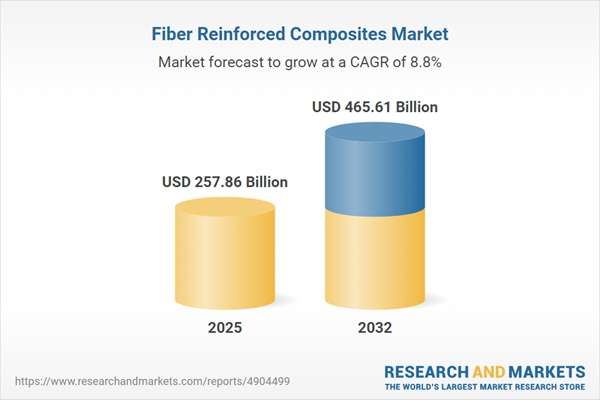Speak directly to the analyst to clarify any post sales queries you may have.
The fiber reinforced composites market is at the forefront of enabling organizations to fulfill critical efficiency, sustainability, and innovation goals across diverse sectors. This report equips senior decision-makers with practical intelligence to deliver business growth, resilience, and compliance as industry dynamics continue to evolve.
Market Snapshot: Fiber Reinforced Composites Market Size & Growth
The global fiber reinforced composites market has reached a valuation of USD 236.51 billion, with projections pointing to USD 257.86 billion by 2025 and a compound annual growth rate of 8.83%. Growth is propelled by advancements in renewable energy, infrastructure, electronics, and core engineering industries. Evolving regulatory requirements for energy efficiency, coupled with continuous developments in material science, are prompting organizations to prioritize composite solutions that balance business outcomes with environmental standards.
Scope & Segmentation: Executive-Level Insights
This report offers detailed analysis to support senior leadership in optimizing procurement and operations in the fiber reinforced composites market. Key areas of strategic relevance include:
- Fiber Types: Focus on aramid for high thermal resistance, and carbon and glass for superior strength-to-weight ratios. These are essential materials for automotive, aerospace, and defense applications.
- Resin Types: Thermoplastic resins such as polyamide, polyether ether ketone, polyphenylene sulfide, and polypropylene enable versatility, while thermoset resins are prioritized for core structural and durability needs.
- Manufacturing Processes: Technologies including autoclave molding, compression molding, filament winding, hand layup, injection molding, pultrusion, and resin transfer molding accommodate precision engineering and scalable production.
- Applications: Sectors covered range from aerospace and defense to transportation, construction, marine, electronics, wind energy, sports, and leisure, with each demanding tailored composite performance over product lifecycles.
- Reinforcement Forms: Engineering flexibility is achieved through multiaxial, unidirectional, woven continuous fibers, chopped strand mat, needled mat, and nonwoven discontinuous forms.
- Regional Coverage: Strategic decision-making must consider trends and compliance across the Americas, Europe, Middle East and Africa, and Asia-Pacific, each region presenting unique sourcing and logistics requirements.
- Leading Companies: Includes Owens Corning, Toray Industries, Teijin Limited, SGL Carbon SE, Hexcel Corporation, Solvay SA, Mitsubishi Chemical Holdings, Johns Manville, Jushi Group, and Gurit Holding AG, all monitored for innovation and market positioning.
Key Takeaways for Senior Decision-Makers
- Advances in continuous fiber and nanomaterial technologies are enabling businesses to sustain product reliability and secure long-term market differentiation.
- Adoption of recyclable thermoplastics and improved resin formulations aligns supply chains with sustainability and responsible sourcing objectives.
- Digital manufacturing, process automation, and advanced controls accelerate product launches and heighten responsiveness to changing sector needs.
- Organizations achieve stronger lifecycle transparency and supply chain resilience through robust assessment and integrated reporting measures.
- Regionalized, flexible manufacturing supports rapid compliance with new regulations and reinforces operational stability amidst shifts in global trade policy.
Tariff Impact: Navigating U.S. Trade Policy & Supply Chain Resilience
Recent U.S. tariff measures have introduced cost fluctuations that require rapid strategic response. Industry leaders are strengthening resilience by investing in localized supply networks, establishing nearshore manufacturing sites, and expanding in-house technical competencies. These initiatives bolster operational continuity and allow organizations to adapt to evolving regulatory landscapes efficiently.
Methodology & Data Sources
This analysis is based on direct interviews with executives and technical experts, alongside data provided by global supply chain partners. All insights are rigorously cross-checked against established industry standards, peer-reviewed research, and primary sources such as patent reviews. This ensures that the report delivers reliable, actionable intelligence.
Why This Fiber Reinforced Composites Report Matters
- Supports executive teams in refining procurement strategies, mitigating exposure, and allocating resources effectively across global supply chains.
- Delivers focused insights that inform board-level decision-making, guide technology investments, and underpin evolving compliance frameworks.
- Enables swift identification of new market opportunities and a proactive stance toward changing sector and regulatory conditions.
Conclusion
Armed with this intelligence, senior leaders can drive organizational innovation, strengthen market positioning, and reinforce stability in the rapidly evolving fiber reinforced composites sector.
Additional Product Information:
- Purchase of this report includes 1 year online access with quarterly updates.
- This report can be updated on request. Please contact our Customer Experience team using the Ask a Question widget on our website.
Table of Contents
3. Executive Summary
4. Market Overview
7. Cumulative Impact of Artificial Intelligence 2025
Companies Mentioned
The companies profiled in this Fiber Reinforced Composites market report include:- Owens Corning
- Toray Industries, Inc.
- Teijin Limited
- SGL Carbon SE
- Hexcel Corporation
- Solvay SA
- Mitsubishi Chemical Holdings Corporation
- Johns Manville Corporation
- Jushi Group Co., Ltd.
- Gurit Holding AG
Table Information
| Report Attribute | Details |
|---|---|
| No. of Pages | 194 |
| Published | October 2025 |
| Forecast Period | 2025 - 2032 |
| Estimated Market Value ( USD | $ 257.86 Billion |
| Forecasted Market Value ( USD | $ 465.61 Billion |
| Compound Annual Growth Rate | 8.8% |
| Regions Covered | Global |
| No. of Companies Mentioned | 11 |









